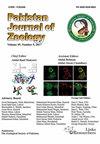巴基斯坦信德省塔塔地区荷斯坦黑布兰和荷斯坦黑布兰-泽西杂交奶牛的发情期同步评价
IF 0.5
4区 生物学
Q4 ZOOLOGY
引用次数: 0
摘要
本研究在信德省塔塔地区研究了进口纯荷斯坦弗里西亚奶牛和荷斯坦弗里西亚-泽西杂交奶牛的发情同步情况。选取30头荷斯坦弗里西亚和荷斯坦弗里西亚-泽西杂交牛,分为A组(10头纯荷斯坦弗里西亚)、B组(10头荷斯坦弗里西亚-泽西杂交牛)和C组(5头纯荷斯坦弗里西亚和5头荷斯坦弗里西亚-泽西杂交牛)作为对照组。所选动物均行超声扫描,确保生殖道正常。A、B组采用Ovsynch方案{GnRH;第0天肌内注射PGF2α (Dalmazin;在第7天肌肉注射FATRO和第9天肌肉注射GnRH以同步发情,而C组动物作为对照组(在第0、7、9天肌肉注射生理盐水作为安慰剂)。各组动物在末次治疗后16 h进行固定时间授精。结果各组间发情反应差异有统计学意义(P<0.05)。B组总体发情反应明显高于B组(80%),其次是A组(60%)和C组(10%)。通过观察发情体征确定发情强度。结果B组的发情征候强度分别高于A、C组的90%、65%、10%、分泌物90%、60%、10%、站立热度80%、60%、10%和嗅阴道80%、70%、10%。发情时间各组间差异有统计学意义(P<0.05)。发情时间以B组最长(15.02±0.21 h),其次为A组(13.58±2.22 h), C组(10±0.00 h)。各组分别于第0天(第1次用药)、第7天、第11天(人工授精后第1天)、第18天和第30天采集乳静脉血样,测定孕酮水平。统计学分析显示,第0天各组孕酮水平差异无统计学意义。第7天,C组孕酮水平显著高于A、B组;A、B组无显著性差异,C组有显著性差异。第11天血黄体酮浓度以C组最高(2.63±0.22),其次为A组(1.65±0.35),最后为B组(1.48±0.22)。统计学分析显示,C组与A、B组比较差异有统计学意义,A、B组比较差异无统计学意义。第18天,P4值最高的是B组(4.20±0.44),其次是A组(3.33±0.39),C组(1.88±0.59)。统计分析显示,B组与A组之间差异无统计学意义,而两组与C组之间差异均有统计学意义。3组患者第30天血孕酮水平均以B组最高(10.90±2.44),其次为A组(8.28±3.33),C组(4.53±0.44)。统计学分析显示,第30天三组间差异有统计学意义。综上所述,在发情反应、周期活性和受精率方面,Ovsynch方案在荷斯坦-泽西杂交奶牛中比在荷斯坦-泽西纯种奶牛中更有效。本文章由计算机程序翻译,如有差异,请以英文原文为准。
Evaluation of Ovsynch Estrus Synchronization in Holstein Friesian and Holstein Friesian-Jersey Crossbred Cows at District Thatta, Sindh, Pakistan
The current study was conducted to assess the ovsynch estrus synchronization in imported pure Holstein Friesian and Holstein Friesian-Jersey crossbred cows at district Thatta Sindh. A total 30 Holstein Friesian and Holstein Friesian-Jersey crossbred cattle were selected and divided into three groups i.e., A (10 pure Holstein Friesian cows), B (10 Holstein Friesian-Jersey crossbred cows), and C (5 pure Holstein Friesian and 5 Holstein Friesian–Jersey crossbred cows) as control group. All selected animals were scanned through ultrasound to ensure the normality of reproductive tract. Animals of group A and group B were treated with Ovsynch protocol {GnRH; (Dalmarelin, FATRO) intramuscular at day 0 followed by PGF2α (Dalmazin; FATRO) intramuscular at day 7 and 2 nd GnRH intramuscular at day 9} for estrus synchronization while animals of group C was kept as untreated control (intramuscular injection of normal saline as placebo on day 0, 7 and 9). Animals of all group underwent fixed time insemination at 16 h of last treatment. Results showed that estrus response vary significantly among the groups (P<0.05). Overall estrus response was observed significantly higher in group B (80%), followed by A (60%) and C (10%). Intensity of estrus was determined by observing the estrus signs. Results showed significantly higher intensity of estrus signs in Group B than A and C for mucus discharge 90%, 65%,10%, flehmen 90%, 60%,10%, standing heat80%, 60%, 10% and sniffing vagina 80%, 70%, 10%, respectively. Estrus duration differs significantly among the treatment groups (P<0.05). Significantly maximum estrus duration was noted in group B (15.02 ± 0.21 h), then A (13.58 ± 2.22 h) and C (10 ± 0.00 h). In all groups blood samples were collected from the milk vein on day 0 (the first treatment), day 7, day 11 (one day after artificial insemination), day 18 and day 30 from all groups for determining progesterone level. Statistical analysis showed non-significant differences in progesterone level among groups at day 0. Furthermore, on Day 7, Group C differed significantly in progesterone level than A and B; however non-significant difference were observed in group A and B, while in group C difference was significant. On day 11 significantly highest values of blood progesterone were seen in group C (2.63 ± 0.22) followed by A (1.65 ± 0.35) and then B (1.48 ± 0.22). Statistical analysis showed that group C was significantly different from A and B, but there was non-significant difference between A and B. At day 18 highest P4 values were seen in B (4.20 ± 0.44) followed by A (3.33 ± 0.39) and then C (1.88 ± 0.59). Statistical analysis showed that group B and A had non-significant difference among each other, while both groups had significant differences with group C. Blood progesterone level for all the three groups on day 30 showed highest values in group B (10.90 ± 2.44) followed by A (8.28 ± 3.33) and C (4.53 ± 0.44). Statistical analysis showed significant difference among all three groups on day 30. It was concluded that in term of estrus response, cyclic activities and fertility rate, Ovsynch protocol was more effective in Holstein Friesian- Jersey cross breed cows than in Holstein Friesian pure cows.
求助全文
通过发布文献求助,成功后即可免费获取论文全文。
去求助
来源期刊

Pakistan Journal of Zoology
生物-动物学
CiteScore
1.10
自引率
16.70%
发文量
306
审稿时长
4.5 months
期刊介绍:
Pakistan Journal of Zoology (Pakistan J. Zool.) publishes original articles in English on all aspects of animal life. Generally these articles will be in, or related to one of the following subject areas: Physiology, Cell Biology, Molecular Biology, Genetics, Bioinformatics, Toxicology, Forensic Science, Developmental Biology, Entomology, Parasitology, Microbiology, Biotechnology, Pathology, Palaeontology. Taxonomy, Environmental Biology, Wildlife, Fisheries, Vertebrate and Invertebrate Morphology. Additionally, the journal considers research on health and clinical studies. Short communications are regularly considered, however, uninvited review articles, first records/reports of known species, case reports/studies and survey reports are not published in Pakistan Journal of Zoology.
 求助内容:
求助内容: 应助结果提醒方式:
应助结果提醒方式:


